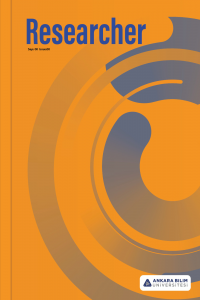The Meaning of the Terms “Physiognomie” and “Physiognomik” in
Der Sinn- und Anwendungsbereich der Begriffe „Physiognomie“ und „Physiognomik“ in der deutschen und türkischen Sprache
physiognomy, inside-outside-dialectic, terminology literature,
___
- Aristoteles (1996). Der Text der pseudo-aristotelischen “Physiognomonica”. Übersetzt von Andreas Degkwitz. In: R. Campe/M. Schneider (Hrgb.) Geschichten der Physiognomik. 1. Aufl. Freiburg im Breisgau: Rombach. S.13-23
- Bozkurt, Ö. (2015). Etiğin Fizyonomik Temellerine Bir Giriş. In: Adam Akademi, Cilt 5/2.S. 27-46.
- Campe, R. & Schneider, M. (Hrgb.) (1996). Geschichten der Physiognomik. Text-BildWissen. Freiburg Breisgau: Rombach.
- Courtine, J. J. (1996). Körper, Blick, Diskurs. Typologie und Klassifizierung in der Physiognomik des Klassischen Zeitalters. In: R. Campe/M. Schneider (Hrgb.) Geschichten der Physiognomik. 1. Aufl. Freiburg im Breisgau: Rombach. S. 211-245.
- Çakır, M. (2007). Kıyâfet-Nâme‘ler Hakkında Bir Bibliyografya Denemesi. In: Türkiye Araştırmaları Literatür Dergisi, Cilt 5, Sayı 9. S. 333-350.
- Degkwitz, A. (1996). Die pseudoaristotelischen “Physiognomonica”. In: R. Campe/M.
- Schneider (Hrgb.) Geschichten der Physiognomik. 1. Aufl. Freiburg im Breisgau: Rombach. S. 23-45.
- Duran, T. (Hrgb.) (1999). Kıyâfetü’l-İnsâniyye fî Şema’ili’l-‘Osmâniyye. İstanbul: Tarihi Araştırmalar Vakfı.
- Gray, R. T. (2003). Physiognomik. In: J. D. Müller (Hrgb.) Reallexikon der deutschen Literaturwissenschaft. Band III. Berlin&Newyork: De Gruyter. S. 79-82.
- Hermann, U. & Matschiner, A. (Hrgb.) (1998). Herkunftswörterbuch: Etymologie, Geschichte und Bedeutung interessanter Wörter der deutschen Gegenwartssprache, Bertelsmann Lexikon. Völlig neu bearbeitet. Gütersloh: Bertelsmann-Lexikon-Verlag.
- Kalverkämper, H. (2003). Physiognomik. In: G. Ueding (Hrgb.). Historisches Wörterbuch der Rhetorik. Band 6: Must- Pop. Tübingen: Max Niemeyer Verlag. S. 1083-1190.
- Macdonald, D. B. (1993a). Firaset. In: İslam Ansiklopedisi, Cilt 4. İstanbul: MEB Yayınları.
- Macdonald, D. B. (1993b). Kıyafet. In: İslam Ansiklopedisi. Cilt 6. İstanbul: MEB Yayinlari.
- Mengi, M. (2002). Kıyafetname. In: Türkiye Diyanet Vakfı İslam Ansiklopedisi, Cilt.25.
- İstanbul: Türkiye Diyanet Vakfı İslam Araştırmaları Merkezi. S. 513-514. Auch vorhanden in: http://www.islamansiklopedisi.info/
- Mengi, M. (1977). Kıyafetnameler Üzerine. In: Türk Dili Araştırmaları Yıllığı (Belleten) Ankara: TDK Yayınları. S. 299-309.
- Pala, I. (2000). Ansiklopedik Divan Şiiri Sözlüğü. İstanbul: Ötüken Yayınları.
- Stimilli, D. (1996). Über Schamhaftigkeit. Ein Beitrag zur historischen Semantik einiger physiognomischer Begriffe. In: R. Campe/M. Schneider (Hrgb.) Geschichten der Physiognomik. 1. Aufl. Freiburg im Breisgau: Rombach. S. 99-125.
- Türk Dil Kurumu (1988). Türkçe Sözlük. Ankara: Türk Tarih Kurumu Basımevi.
- Uludağ, S. (2009). Firaset. Kıyafetname. In: Türkiye Diyanet Vakfı İslam Ansiklopedisi.
- Cilt. 25. İstanbul: İSAM: Türkiye Diyanet Vakfı İslam Araştırmaları Merkezi. S. 513-514.
- Wahrig (1986). Deutsches Wörterbuch. München: Mosaik Verlag.
- Wolf, W. (2002). "Speaking Faces". Zur epistologischen Lesbarkeit von Physiognmomiebeschreibungen im englischen Erzählen des Modernismus. In: Joachin
- Küpper (Hrgb.). Sonderausdruck aus Poetica. Zeitschrift für Sprach- und Literaturwissenschaft. 34. Band. Heft 3-4. S. 389-426.
- Aerni, F. (2008). Physiognomik: Die Sprache der Natur. Zurich: Carl Huter Verlag. www.carl-huter.ch/pdf/physiognomik.pdf 02.12.2015.
- Deutsches Wörterbuch von Jakob und Wilhelm Grimm. http://woerterbuchnetz.de/DWB/ 10.01.2016.
- Duden. http://www.duden.de/ 26.10.2015. DWDS-Das Digitale Wörterbuch der deutschen Sprache. http://www.dwds.de/ 27.10.2015.
- Lavater, J. K. (1772). Von der Physiognomik. (Projekt Gutenberg-DE). http://gutenberg.spiegel.de/buch/von-der-physiognomik-752/1 25.10.2015.
- Nişanyan, S. (2002). Sözlerin Soy Ağacı: Çağdaş Türkçenin Etimolojik Sözlüğü. http://www.nisanyansozluk.com/ 15.01. 2016.
- TDK. Güncel ve Büyük Türkçe Sözlük. http://www.tdk.gov.tr/ 26.09.2019. Wörterbuch Linguee. http://www.linguee.de/deutschitalienisch/search?source=auto&query=physiognomie 09.06.2017.
- ISSN: 2717-9494
- Yayın Aralığı: Yılda 2 Sayı
- Başlangıç: 2013
- Yayıncı: Ankara Bilim Üniversitesi
Şeyhülislâm Hocazâde Muhammed Efendi’nin Manzum Fetvâları II
İnovasyon ve Entelektüel Sermaye Arasındaki İlişkinin İşletmeler Açısından İncelenmesi
Akıllı Şehir Projelerinde Karar Alma ve Koordinasyon Yaklaşımları
The Meaning of the Terms “Physiognomie” and “Physiognomik” in
Suça Teşvik Eden Dijital Oyunların Çocuklar Üzerindeki Etkileri ve Bu Etkilerden Korunma Yöntemleri
Derya KANTAR ÖZKES, Büşra KANTAR, Fırat KOÇ, Vahdet ÖZKOÇAK
1260-61 / 1844-45 Temettuat Kayıtları Işığında Karaköselü Köyünün Sosyal ve Ekonomik Yapısı
